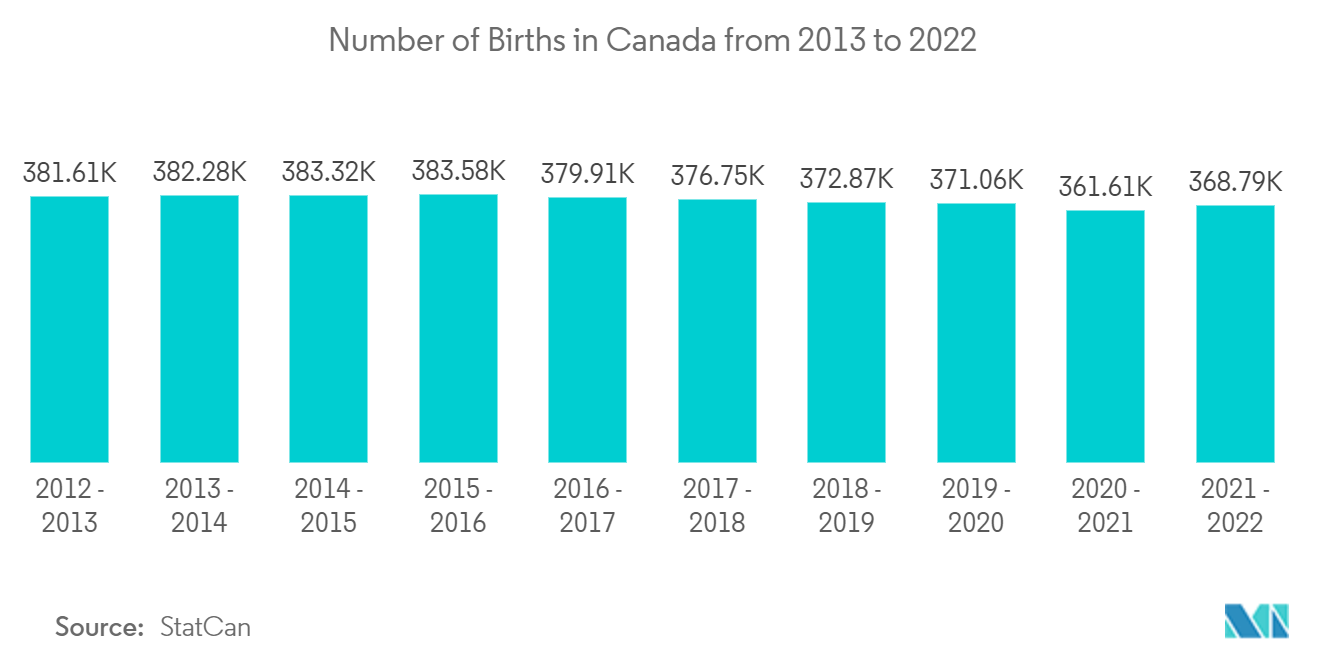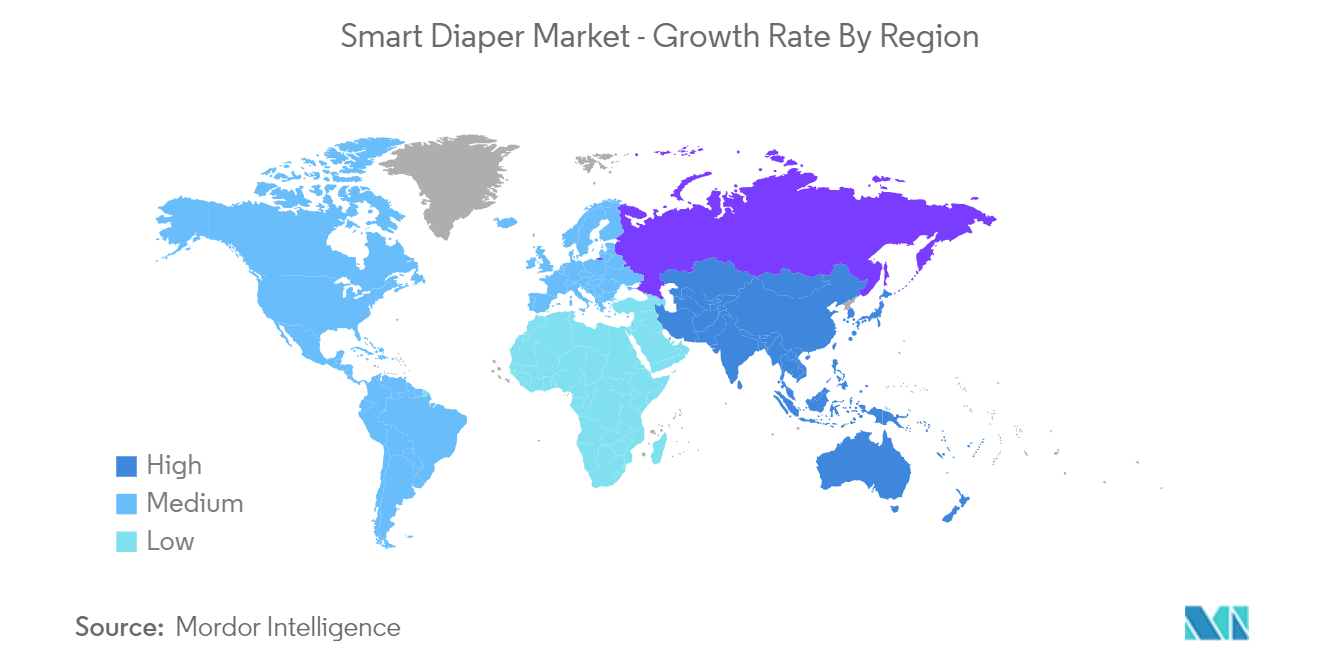Market Trends of Smart Diaper Industry
The Rising Baby Care Will Act as a Major Driver of the Market
- The well-being of infants is of utmost importance and requires diligent attention. Consequently, numerous corporations employ advanced technologies like Alert Plus in smart diapers. An example of such innovation is the Smart Pee sensor, which incorporates a unique algorithm to provide timely information on temperature and humidity levels. These diaper technologies enable the creation of statistical data through applications, facilitating the tracking of diaper usage and bowel activity and issuing alerts when a diaper change is necessary.
- The market for smart diapers is experiencing growth due to increasing birth rates in both developed and developing nations and the growing prevalence of Internet usage. Furthermore, the rise of IoT devices and heightened consumer demand for smart connected products are expected to drive market expansion further. Additionally, the potential for smart diapers to monitor urine incontinence and diaper moisture levels to prevent skin ailments presents an attractive opportunity for market growth.
- The demand for smart diapers for infants is witnessing substantial growth owing to the escalating demand for baby care products and the expanding global population of newborns. The market is witnessing the emergence of various opportunities and trends that can prove advantageous for manufacturers and retailers of baby diapers. These manufacturers are investing in advanced technologies to create diapers of superior quality, offering improved absorbency, comfort, and flexibility, thereby catering to the requirements of discerning consumers. For instance, In 2022, India recorded the highest number of births, with 23 million, as per WorldMapper. China followed with 10 million, while Nigeria, Pakistan, and Indonesia registered 8 million, 6.4 million, and 4.5 million births respectively.
- Furthermore, smart diapers are beneficial for infants as they aid in preventing skin rashes and allergies on their delicate skin. Additionally, this system assists mothers and caregivers in identifying excretion patterns and training infants in natural processes at an early stage. Smart diapers prevent wetness and spoilage and monitor sleeping and breathing patterns. Manufacturers are currently developing fluffless diapers that absorb excess liquids.
- The e-commerce channel has emerged as a crucial distribution avenue for baby diaper products, propelled by the increasing prevalence of smartphones and internet access. The convenience and simplicity of online shopping have led consumers to increasingly opt to purchase baby diapers through this platform, giving manufacturers an opportunity to enhance their online visibility.

Asia-Pacific is Expected to be the Fastest Growing Market
- The Asia Pacific region is projected to experience the most rapid growth rate during the forecasted period. The market in the region is being propelled by the emergence of numerous startups developing new sensor technologies. The primary drivers of the market are the growing population and the prevalence of nuclear families in the region. Taiwan, Korea, and Australia are identified as emerging markets for this product. Furthermore, the increasing adoption of advanced care technologies for infants, adults, and the elderly is expected to drive significant demand in the Asia-Pacific region.
- Over 50 percent of the global population is comprised of individuals residing in Asia, a region projected to have the highest urban population by 2050. With India and China being the most populous countries in the world, Asia is anticipated to present significant market opportunities, particularly in the forecasted period, due to the addition of a substantial number of infants. For instance, the International Monetary Fund predicts that India's population will reach approximately 1,406.63 million by 2022, with further growth expected in subsequent years. Consequently, the rising population in the region will drive an increased demand for smart diapers.
- Prominent nations within the Asia-Pacific region, such as Japan, China, India, and South Korea, have successfully curtailed infant mortality rates owing to population expansion and the advancement of healthcare standards. Moreover, the demographic shift from rural to urban localities propelled the demand for intelligent diapers in Asia-Pacific countries. Notably, China's infant mortality rate has declined from 5.4 per 1,000 in 2020 to 5 per 1,000 in 2021, as the State Council Commission reported, and is projected to continue decreasing in the foreseeable future.
- According to the Hindawi Publishing Corporation, eco-diapers designed for infants aged 24 months and below are extensively utilized in India and China, with the Philippines and Japan following suit. By incorporating conductive yarns and sensors, these diapers can effectively detect moisture levels, triggering an alarm when significant moisture is detected.
- The market development potential in the region is significant due to the substantial proportion of elderly residents. Prominent nations in the Asia-Pacific region, such as Japan, China, India, and South Korea, have witnessed a rise in the aging population and improved healthcare standards. Additionally, the smart diaper market is experiencing a growing trend of technological advancements, particularly in the form of wireless or Bluetooth-enabled moisture sensors attached to the diaper's exterior. These sensors are supported by durable batteries that enable long-range internet connectivity. Furthermore, as stated in the Report of the Technical Group on Population Projections for India and States 2011-2036, the elderly population in India is projected to reach approximately 138 million individuals in 2021, comprising 67 million males and 71 million females. This number is anticipated to increase by approximately 56 million individuals by 2031. Similarly, the Chinese government reports that China's population of 1.44 billion is experiencing rapid aging. Individuals aged 65 years and older currently comprise 12.0 percent (173 million) of the people, which is expected to rise to 26.1 percent (366 million) by 2050.
- The increasing geriatric population is anticipated to make a substantial contribution to market demand. The market is expected to be driven by nursing homes, healthcare institutions, and clinics catering to elderly patients during the forecast period. Additionally, WHO data reveals that by 2025, 18 percent of Asia's population will be aged 65 or older, representing an 11 percent increase from 2010 levels. This trend is expected to create significant opportunities for the market, particularly as families become more nuclear in the region, resulting in a demand for smart diapers.

